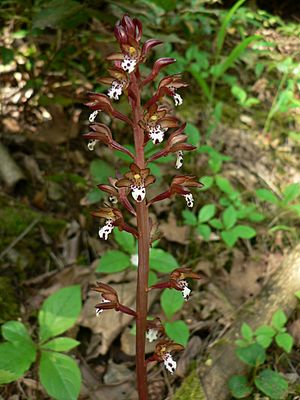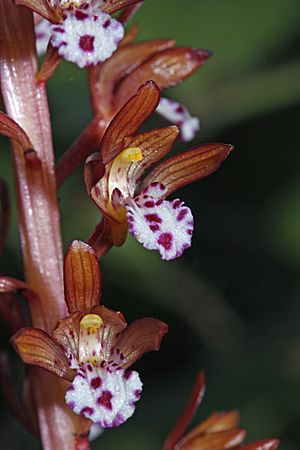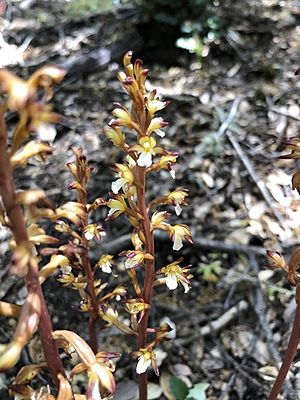Spotted coralroot facts for kids
Quick facts for kids Spotted coralroot |
|
|---|---|
 |
|
| Scientific classification | |
| Genus: |
Corallorhiza
|
| Species: |
maculata
|
| Synonyms | |
|
|
Corallorhiza maculata, also known as the spotted coralroot, is a special type of coralroot orchid found in North America. It has three main kinds: C. maculata var. occidentalis (western spotted coralroot), C. maculata var. maculata (eastern or summer coralroot), and C. maculata var. mexicana.
This orchid grows across a wide area. You can find it in Mexico, Guatemala, Canada, and even St. Pierre & Miquelon. It also grows in many parts of the western and northern United States. However, it is usually not found in the Great Plains or the lowlands of the Southeast. Spotted coralroot prefers to grow in mountain woodlands.
Contents
What Does Spotted Coralroot Look Like?
The spotted coralroot is a very unique plant. Unlike most plants, it does not have chlorophyll. This means it cannot make its own food using sunlight. Instead, it gets its energy by connecting with fungi from the Russulaceae family. This special way of getting food is called myco-heterotrophy.
The plant's underground stem, called a rhizome, and its lower stem often look like branched coral. The stem is usually red or brown, but sometimes it can be light yellow or cream. Since it doesn't use sunlight, it has no green leaves. The stems have dark red scales and beautiful orchid flowers.
Flowers of the Spotted Coralroot
The flowers of Corallorhiza maculata are small and grow all around the stem. The sepals, which are like small leaves protecting the flower, are dark red or brown with a hint of purple. They are long and pointed. The side petals are reddish. The most striking part is the lip petal, which is bright white with deep red spots. This lip petal usually has wavy edges and is about 7 to 10 millimeters long. Some types of this orchid might have a plain white lip without any spots.
How People Have Used Spotted Coralroot
Long ago, several Native American groups used parts of the spotted coralroot. They would dry the stems and brew them into a tea. This tea was used to help with things like colds, pneumonia, and skin irritation.
The spotted coralroot is also famous for being the subject of a poem. The well-known poet Robert Frost wrote about it in his poem called On Going Unnoticed.
See also
 In Spanish: Corallorhiza maculata para niños
In Spanish: Corallorhiza maculata para niños



